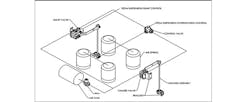Barksdale: Reducing downtime with air-suspension blocking, second ride-height function
Editor’s note: The following white paper on air-suspension valves and vehicle ride-height functions was provided by Barksdale Control Products.
Vocational vehicles have different operations based on their function. In daily operation, one aspect of keeping cost down is dependent on preventing damage to air springs, the chassis, or the underside of the trailer.
To prevent this kind of damage, save cost and time, and avoid a complicated multi-valve solution, a single air suspension valve with blocking function or second ride height function is needed.
Blocking function
Fleets operating certain specialized vocational vehicles or trailers can incur significant downtime and repair costs when air springs are under-inflated and bottom out, damaging the air-springs bellow.
Air-suspension systems can face a risk of air-spring damage known as “pinching.” This occurs in applications if air springs are depressurized and stretched into “hour-glass” shape. As the distance between the frame and axle(s) increases, the height-control valve (HCV) tries to return the vehicle to normal ride height by discharging air from the air springs, allowing the bellow to be pulled into an “hour glass” shape. So when the vehicle returns the axle and frame to its normal position, the air-spring bellows can become pinched between the top plate and piston, leading to permanent deformation and damages.
Such pinching damages the air springs and requires replacement. Replacement can be costly, totaling a minimum of $1,400 for material, labor, towing, and vehicle downtime. In addition, air-spring manufacturers will not warranty a unit destroyed by under-inflation; the entire repair cost is borne by the vehicle operator. A solution is to keep the air springs pressurized when the vehicle is lifted from its outriggers so that pinching does not occur.
In order to prevent air springs from depressurizing during this condition, the exhaust circuit of the height-control valve needs to be isolated. A solution to this can come from an air suspension system that is equipped with a valve that can perform blocking. The blocking function prevents release of air from air springs.
An early solution to maintaining air pressure in the spring was to install additional components in the form of manual or electric bypass valves and pneumatic plumbing. This increased complexity and cost, and was more difficult to troubleshoot.
A more cost- and space-efficient solution has recently been developed—a valve that integrates ride-height control during over-the-road operation and blocks air-spring discharge/filling when activated. Such a system is dependent on only one valve to achieve the blocking function and control ride height.
The Atlas height-control valve with integral blocking function, is a more efficient and cost effective alternative. By activating a pilot signal, the blocking function prevents air springs from exhausting and filling. Consequently, when the truck is lowered from its outriggers, there is sufficient air pressure in the air springs to prevent damage. This capability is integrated within existing air suspension systems without extra accessories or complexity.
The blocking feature on a height-control valve ultimately lowers the cost of ownership for trucks prone to developing pinched air springs. Material, labor, and downtime cost for air-spring replacements can be expensive. This cost can be eliminated with a cost-effective solution: a single valve that has a blocking functionality, also known as air retention.
Second ride-height function
In operating vocational vehicles or trailers, to prevent damage to the underside of the truck or trailer, and raised lift-axle wheels, a common method has been to raise and lower the vehicle or trailer by a mechanism that the driver can control. Some of the more recent technologies utilize air suspension to control ground clearance.
Typically, an air-suspension system with dual ride height relied on an air feed that was controlled by two or three valves. While such systems did work, they were unnecessarily complex as they utilized more than one height-control valve, plus related accessories. This contributed to an increase in cost of ownership, and if such a system broke down, the corresponding downtime to troubleshoot and repair would be unnecessarily long.
A better method has been developed: The single-valve system. Such a system is dependent on only one valve to achieve dual ride height.
Specific examples of uses that require additional ground clearance include the following:
Lowboy trailers that utilize lift axles face a unique challenge due to the nature of the chassis design as shown in the image below. Chassis are designed to deflect under the load. As the frame deflects, the frame-to-ground distance increases, which changes the ride height. Without a load on the trailer, the lifted tag axle has much less ground clearance, contributing to the risk of wear and impact damage of High centering can occur when a vehicle goes over an obstacle, such as a hillcrest, and becomes immobilized with either front or back axle suspended in air. This typically results in unnecessary delays in transport and almost invariably leads to damage of the chassis or the underside of the trailer.
Furthermore, when vocational trucks are driving off-road, additional ground clearance is required to drive over uneven road surfaces and obstacles. In these situations, it is an absolute requirement for the vehicle to have the option to raise the chassis to prevent damage to chassis components.
To gain additional ground clearance, most truck and trailer OEMs currently utilize an additional ride-height control valve. This second valve enables the truck or trailer to raise its chassis to a higher ride height. When higher ground clearance is required, the operator/system switches to the secondary height-control valve. To make this system work, an additional control valve is needed to select between the two ride-height control valves. While this system performs adequately, it is not considered cost-effective.
The list of factors adding to cost over what it would be in a single-valve design includes:
- Three valves are used instead of one
- Additional brackets and linkages
- Additional fittings and tubing
- Increased labor cost due to setting the ride height via an additional valve, welding additional bracket to the frame, and installation of additional component
Factors that increase maintenance and operating cost for end user:
- Difficult to troubleshoot due to system complexity
- Additional potential leak paths
- In most cases, increased downtime when the system malfunctions
Single-valve dual ride height chassis systems are simpler, more cost-effective, and more robust. A single-valve dual ride height air-suspension chassis system does the same work as a multiple-valve system and is used in the same applications. The difference is that multiple-valve systems require extra valves and corresponding hardware, adding to complexity and cost over the lifecycle of the system or vehicle. The same basic principles apply in the design and operation of a single-valve air-suspension chassis system.
However, a unique kind of valve is required to operate a single-valve system. The valve’s mechanism provides two different ride heights. The valve is coupled to an internal cartridge that selects between two ride heights when activated by a pilot signal initiated by the driver of the vehicle. In lift-axle applications, the installation is even simpler, as the pilot signal can be provided to the valve from the lift-axle raise/lower air circuit. With this arrangement, the second (higher) ride height is initiated automatically, whenever the lift-axle is raised. The second ride height can be customized based on intended use of the vehicle, and will be factory set to be anywhere between 1 to 4 inches. This is an efficient solution as it eliminates several components that a two-valve design requires. It is simpler to install, easier to troubleshoot, and has a lower total cost of ownership. Typically, the valve deployed in the single-valve configuration will include a quick-dump feature and can be activated from either ride height.
The major benefits of using a single-valve design include easier and faster installation, easier and faster maintenance, and reduced downtime while in operation by end users—all leading to cost savings.
These savings accrue during the initial manufacturing process and continue throughout the service life of a vocational vehicle. Fewer valves and other parts are needed to produce a single-valve air-suspension setup, and fewer parts must be maintained or replaced by the end user over the life of the vehicle. A simpler system breaks down less frequently than a more complex one, and when it does, it is cheaper and easier to repair. Downtime is reduced, creating additional savings.



